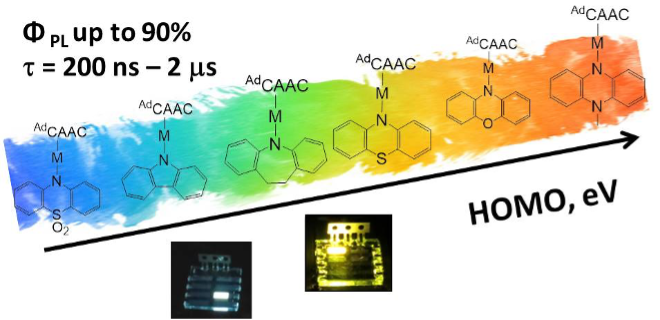Carbene metal amide photoemitters: tailoring conformationally flexible amides for full color range emissions including white-emitting OLED
Published in Chemical Science, 2019
Authors: Alexander S. Romanov, Saul T. E. Jones, Qinying Gu, Patrick J. Conaghan, Bluebell H. Drummond, Jiale Feng, Florian Chotard, Leonardo Buizza, Morgan Foley, Mikko Linnolahti, Dan Credgington, Manfred Bochmann.

Abstract
Conformationally flexible “Carbene–Metal–Amide” (CMA) complexes of copper and gold have been developed based on a combination of sterically hindered cyclic (alkyl)(amino)carbene (CAAC) and 6- and 7-ring heterocyclic amide ligands. These complexes show photoemissions across the visible spectrum with PL quantum yields of up to 89% in solution and 83% in host-guest films. Single crystal X-ray diffraction and photoluminescence (PL) studies combined with DFT calculations indicate the important role of ring structure and conformational flexibility of the amide ligands. Time-resolved PL shows efficient delayed emission with sub-microsecond to microsecond excited state lifetimes at room temperature, with radiative rates exceeding 10$^6$ s$^{−1}$. Yellow organic light-emitting diodes (OLEDs) based on a 7-ring gold amide were fabricated by thermal vapor deposition, while the sky-blue to warm-white mechanochromic behavior of the gold phenothiazine-5,5-dioxide complex enabled fabrication of the first CMA-based white light-emitting OLED.
Recommended citation: Romanov, A.S., Jones, S.T., Gu, Q., Conaghan, P.J., Drummond, B.H., Feng, J., Chotard, F., Buizza, L., Foley, M., Linnolahti, M. and Credgington, D., 2020. Carbene metal amide photoemitters: tailoring conformationally flexible amides for full color range emissions including white-emitting OLED. Chemical Science, 11(2), pp.435-446.
